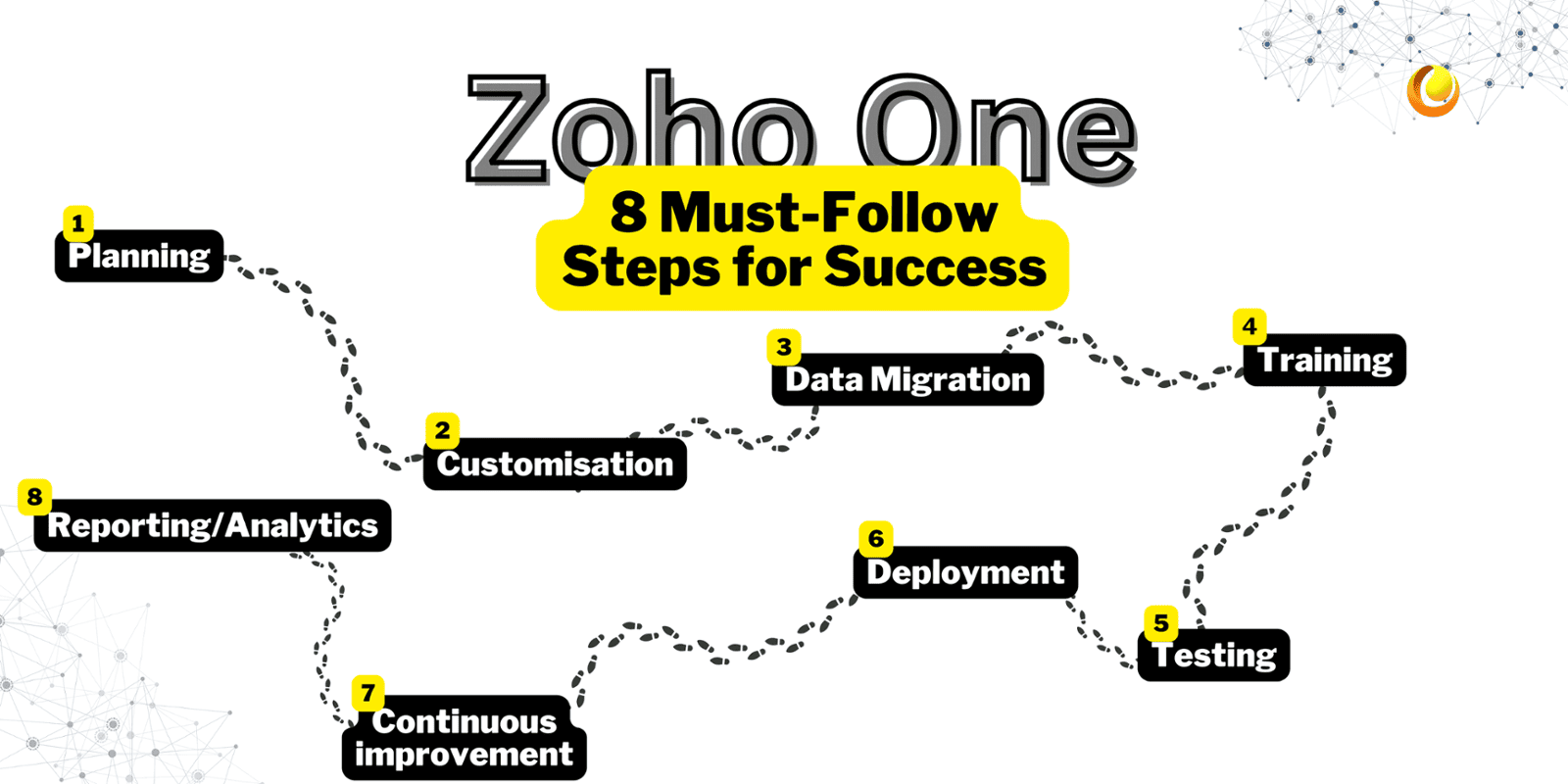Curious about Zoho One and how it can transform your business? Explore our expert guide to uncover the essential 8-step roadmap for success with Zoho One. Whether you're an experienced entrepreneur or new to the game, master the art of Zoho One like a pro. Let's kickstart your business journey with Zoho One!

- Introduction
- Are You Strategically Planning Your Zoho One Implementation?
- How Can You Tailor Zoho One to Fit Your Business?
- How to Migrate Data to Zoho One?
- Are Your Team Members Trained?
- Are You Ready for a Flawless Deployment?
- How to Successfully Launch Zoho One?
- How Can You Ensure Continuous Improvement?
- Are You Using Zoho One's Reporting and Analytics?
- Conclusion
Don't get confused between Zoho One and Zoho CRM. Watch this short video if you are not familiar with Zoho.
Introduction
Welcome to the era of technology – where businesses of all sizes are empowered with a suite of tools designed to streamline operations, boost productivity and supercharge growth. But diving into this comprehensive ecosystem requires more than just a click of a button. It demands a strategic approach, thoughtful planning and a keen understanding of how to harness its full potential.
In this guide, we're going to take you through the eight essential steps for a successful Zoho One implementation. Think of it as your roadmap to Zoho mastery – a blend of expert advice and practical tips to help you navigate the complexities and unlock the power of this integrated platform.
Whether you're a seasoned entrepreneur or a budding startup, our goal is to demystify the process and equip you with the knowledge and tools you need to thrive in the world of Zoho One. So, buckle up and let's embark on this journey together. It's time to master Zoho One like a pro.
Are You Strategically Planning Your Zoho One Implementation?
1. Identifying Business Needs: Pinpoint the specific challenges and opportunities Zoho One could address within the organisation. Understanding these needs enables teams to prioritise tasks and allocate resources effectively.
2. Defining Goals & Objectives: Set measurable targets related to productivity improvements, cost savings, revenue growth, or enhanced customer satisfaction. These goals provide benchmarks for measuring progress.
3. Mapping Existing Processes: Analyse current business processes to identify bottlenecks, redundant activities and areas for improvement.
4. Selecting Apps & Features: Choose Zoho apps and features that align with identified needs and goals, ensuring seamless integration and strategic alignment.
5. Creating a Blueprint: Develop a detailed plan outlining events, milestones, deliverables, timelines and responsibilities associated with the implementation. This serves as a reference for stakeholders, clarifying expectations and roles.
6. Estimating Resources: Assess the human capital, financial investments and technological infrastructure required for successful implementation. Allocate resources appropriately to avoid delays and maintain momentum.
7. Risk Management: Anticipate potential obstacles and develop strategies to mitigate them proactively. Identifying risks early enables teams to minimise disruptions and safeguard the Zoho One investment.
8. Communication Strategy: Design an effective plan to inform employees about upcoming changes, share updates and solicit feedback. Involving employees in decision-making fosters buy-in and active participation in the transformation process.
By carefully considering these factors during the planning phase, organisations can position themselves for success when implementing Zoho One. Neglecting adequate preparation may lead to suboptimal outcomes, missed opportunities and wasted resources. Thus, investing in a comprehensive blueprint is crucial for achieving long-term success with Zoho One.
How Can You Tailor Zoho One to Fit Your Business?
1. Configuring Applications: Businesses can adjust settings and parameters within individual Zoho applications to match specific requirements. This includes modifying field names, adding custom fields, adjusting layouts and defining record relationships.
2. Workflow Automation: Setting up automated actions triggered by predefined conditions helps save time and reduces manual errors. Workflow rules enable users to configure sequences of actions like sending emails, updating records, assigning tasks and generating notifications.
3. Integrations: Connecting Zoho One with third-party applications and services facilitates seamless information exchange between platforms. Integrations enhance collaboration, increase visibility across departments and ensure data consistency.
4. Forms and Templates: Building customised web forms and templates aids in capturing leads, gathering feedback and collecting data from external sources. These forms and templates can be embedded directly onto websites or shared via email campaigns.
5. Branding: Personalising the appearance of Zoho One applications with branded themes, logos and colour schemes contributes to a cohesive user experience and boosts employee engagement.
6. Data Import and Migration: Transferring existing data from legacy systems into Zoho One eliminates duplication, preserves historical records and accelerates adoption rates among end-users.
7. Reporting and Analytics: Generating customisable dashboards and reports using built-in analytics capabilities or third-party add-ons enables tracking of performance metrics, monitoring KPIs and gaining insights into business trends.
To ensure successful custom isation efforts, organisations should adhere to best practices such as maintaining documentation, regularly backing up data and seeking guidance from experienced Zoho consultants when needed. Moreover, involving end-users in the customisation process is crucial for obtaining valuable input and feedback. Through collaboration, businesses can establish a robust and user-friendly Zoho One environment that supports their evolving needs and fosters sustainable growth.
How to Migrate Data to Zoho One?
During this stage, businesses embark on transferring their existing data from legacy systems to Zoho One. Data migration stands as a pivotal step in the mplementationprocess, guaranteeing that the new system harbours accurate and up-to-date information crucial for smooth business operations. Here are some key considerations for ensuring a successful data migration:
1. Data Mapping: Begin by identifying the specific data fields and records slated for migration from the legacy system to Zoho One. Create a comprehensive mapping document delineating the source and destination fields, data types and any necessary transformations.
2. Data Cleansing: Prioritise cleansing the data to eliminate duplicates, rectify inconsistencies and rectify errors. This meticulous step guarantees that the migrated data maintains accuracy and reliability.
3. Data Validation: Thoroughly validate the migrated data to confirm its alignment with the source data and to mitigate any potential data loss or discrepancies.
4. Data Security: Usher in stringent measures to safeguard the migrated data against unauthorised access. Implement robust security protocols such as access controls, encryption and routine backups to fortify data integrity.
5. Data Volume: Assess the volume of data earmarked for migration and strategise accordingly to minimise downtime and prevent disruptions to ongoing business activities.
6. Data Migration Tools: Leverage proficient data migration tools to automate and streamline the migration process, thereby reducing manual effort. Zoho One offers built-in data migration tools designed to simplify the process and uphold data integrity.
By adhering to these best practices, businesses can navigate a seamless and triumphant data migration journey. A meticulously executed data migration ensures that the new system is enriched with precise and dependable data, laying a robust foundation for informed business decision-making.
Are Your Team Members Trained?
During this stage, businesses prioritise equipping their employees with the necessary knowledge and skills to effectively utilise Zoho One. Proper training not only ensures confident and productive adoption of the new system but also leads to heightened user satisfaction and increased return on investment (ROI).
Here are the key components of effective training programs:
1. Onboarding Sessions: Initiate introductory training sessions aimed at acquainting employees with the fundamental functions and features of Zoho One. These sessions cover essentials like navigating the interface, logging in and executing routine tasks.
2. Role-Based Training: Tailor training to specific job roles to ensure employees acquire skills pertinent to their responsibilities. Role-based training enhances learning retention and minimises confusion by focusing on relevant content.
3. Hands-on Practice: Foster hands-on practice to solidify newly acquired skills and encourage experimentation. Practical exercises help employees gain confidence in the system and explore innovative ways to leverage its capabilities.
4. Interactive Learning Materials: Employ interactive learning materials such as videos and infographics to engage employees and make learning enjoyable. These materials accommodate diverse learning styles and facilitate better information retention compared to traditional methods.
5. Continuous Support: Offer ongoing support to employees beyond initial training sessions. Accessible support channels assist users in addressing questions or issues encountered during regular usage, fostering confidence and independence.
6. Feedback Mechanisms: Establish mechanisms for soliciting feedback from employees to assess their comprehension and pinpoint areas requiring additional instruction. Feedback also informs the refinement of training materials to adapt to evolving organisational needs.
By delivering high-quality training programs, businesses empower employees to fully embrace Zoho One, driving positive outcomes. Effective training not only enhances user proficiency but also contributes to elevated morale, motivation and organisational culture, fostering an environment conducive to innovation.
Are You Ready for a Flawless Deployment?
During this stage, businesses undertake rigorous testing of the Zoho One system to guarantee it aligns with their business needs and operates as intended. Testing plays a pivotal role in the implementation process by pinpointing and rectifying issues before the system's official launch. Some key considerations for successful testing:
1. Test Plan: Develop a comprehensive test plan delineating testing objectives, scope, methodology and team. Additionally, outline the testing environment and tools to be utilised.
2. Test Cases: Create a suite of test cases covering functional, performance and security aspects of the system. These test cases should mirror real-world scenarios and use cases to ensure thorough evaluation.
3. Test Data: Curate test data that accurately reflects the organisation's business processes and data structures. The test data should closely resemble actual data expected to be used within the system.
4. Test Execution: Execute test cases in adherence to the established test plan, meticulously documenting results. It's crucial to conduct testing in a controlled environment to mitigate any potential impact on production systems.
5. Defect Management: Implement robust defect tracking and management procedures to prioritise and resolve identified issues promptly. Prioritisation should be based on severity and potential impact to ensure efficient resolution before the system's launch.
6. User Acceptance Testing (UAT): Engage end-users in user acceptance testing to validate the system's alignment with their needs and expectations. UAT involves users testing the system in real-world scenarios to confirm its suitability.
7. Regression Testing: Perform regression testing post-system updates or changes to verify that existing functionalities remain unaffected. This ensures that no unintended consequences arise from system modifications.
By adhering to these best practices, businesses can conduct thorough testing of the Zoho One system, ensuring it meets their requirements before deployment. Effective testing mitigates the risk of downtime, data loss and disruptions, fostering a smooth transition to the new system.
How to Successfully Launch Zoho One?
During this pivotal stage, businesses usher in Zoho One as the cornerstone tool for the entire company. The deployment marks the culmination of extensive preparation and signifies the initiation of a long-term journey toward success. Successful deployment hinges on meticulous attention to the following factors:
1. Go Live Date: Strategically select a go-live date that harmonises with the organisation's schedule, minimising disruption to daily operations. Communicate the go-live date clearly and consistently to all stakeholders to ensure alignment.
2. Change Management: Execute effective change management strategies to navigate the transition from the old system to Zoho One seamlessly. Focus on addressing employee concerns, fostering excitement for the new system and articulating the value proposition of Zoho One.
3. End-user Training: Reinforce end-user training to ensure widespread proficiency in using Zoho One. Conduct training sessions just before or immediately after the go-live date to refresh employees' understanding and address any lingering questions.
4. System Availability: Guarantee uninterrupted availability and functionality of Zoho One. Employ vigilant monitoring to promptly identify and resolve any technical issues that may arise, ensuring smooth operation.
5. Performance Metrics: Establish performance metrics to gauge the effectiveness of Zoho One. Evaluate its impact on meeting business objectives, enhancing operational efficiencies and driving competitive advantage.
6. Ongoing Support: Provide continuous support to employees post-go-live. Ensure readily available assistance to address any inquiries or issues encountered during regular operations, fostering confidence and efficacy.
7. Employee Feedback: Gather feedback from employees to assess Zoho One's effectiveness and pinpoint areas for enhancement. Regular feedback collection informs ongoing development and optimisation efforts, ensuring alignment with evolving needs.
By adhering to these best practices, businesses can orchestrate a seamless and triumphant deployment of Zoho One. A well-executed deployment not only boosts user adoption rates but also elevates employee morale and yields tangible business outcomes.
How Can You Ensure Continuous Improvement?
Continuous improvement is vital to maintaining the effectiveness and relevance of the Zoho One system over time. This ongoing process involves refining, optimising and expanding the system to align with evolving business needs and technological advancements. Here are key considerations for continuous improvement.
1. Feedback Collection: Actively solicit feedback from end-users, administrators and stakeholders to pinpoint pain points, areas for enhancement and new feature requests. Utilise various channels such as surveys, focus groups and individual discussions to gather feedback effectively.
2. Feature Adoption: Stay informed about new features and updates released by Zoho and encourage their adoption within your organisation. Regularly assess how these enhancements can improve workflows and drive efficiency.
3. Process Automation: Identify opportunities for further process automation within Zoho One. Automating repetitive tasks and streamlining workflows can lead to significant time and cost savings while enhancing productivity.
4. Integration Expansion: Explore additional integrations with third-party applications to broaden the capabilities of Zoho One. Integrations enable seamless data exchange between systems, facilitating a more comprehensive view of operations and improving decision-making.
5. User Training: Provide ongoing training to ensure users are well-versed in new features and best practices. Regular training sessions help users stay up-to-date with the system's capabilities and maximise its potential.
6. System Health Monitoring: Implement robust system health monitoring to proactively identify and address any performance or stability issues. Regular monitoring helps prevent potential disruptions and ensures optimal system performance.
7. Governance and Compliance: Maintain compliance with relevant regulations and internal governance policies. Conduct regular audits to identify and address any areas of non-compliance, safeguarding data security and integrity.
By prioritising continuous improvement, organisations can derive maximum value from Zoho One over time. This iterative approach fosters agility, enabling businesses to adapt to changing market dynamics and harness new technologies as they emerge.
Are You Using Zoho One's Reporting and Analytics?
During this pivotal stage, businesses harness the power of reporting and analytics to glean actionable insights, enabling informed decision-making and driving organisational success. Reporting and analytics serve as indispensable tools for evaluating the effectiveness of Zoho One implementation and showcasing its return on investment. Some key considerations for optimising reporting and analytics:
1. KPI Definition: Define clear and relevant key performance indicators (KPIs) that align with the organisation's strategic objectives and Zoho One implementation goals. These KPIs serve as benchmarks for measuring success and tracking progress over time.
2. Data Visualisation: Utilise intuitive data visualisation techniques such as charts, graphs and tables to transform complex data sets into easily understandable formats. Effective data visualisation enhances comprehension and facilitates informed decision-making among stakeholders.
3. Real-time Insights: Harness the power of real-time data to generate timely and actionable insights. Real-time insights enable agile decision-making, empowering businesses to respond swiftly to changing market dynamics and emerging opportunities.
4. Predictive Modelling: Employ advanced predictive modelling techniques to forecast future trends, anticipate customer behaviours and identify potential risks. Predictive models provide valuable foresight, enabling proactive strategic planning and resource allocation.
5. Collaborative Analysis: Foster collaboration among cross-functional teams to analyse data and extract meaningful insights. Collaborative analysis promotes knowledge sharing, breaks down departmental silos and fosters a holistic understanding of business performance.
6. Security and Privacy: Implement robust security protocols and privacy standards to safeguard sensitive data and protect against unauthorised access. Maintaining data security and privacy is essential for building trust with customers and ensuring compliance with regulatory requirements.
7. Scalability: Ensure the reporting and analytics infrastructure can scale seamlessly to accommodate growing volumes of data and increasing user demands. Scalable infrastructure enables businesses to maintain performance and reliability as they expand and evolve.
By leveraging reporting and analytics effectively, businesses can unlock valuable insights, optimise operational performance and drive sustainable growth. Furthermore, robust reporting and analytics capabilities demonstrate the tangible value of Zoho One to stakeholders, reinforcing the justification for continued investment in the platform.
Conclusion
In wrapping up, it's clear that diving into the world of Zoho One requires more than just a click of a button - it takes strategic planning, thoughtful execution and ongoing dedication. Throughout this guide, we've covered the essential steps needed to make your Zoho One implementation a success.





